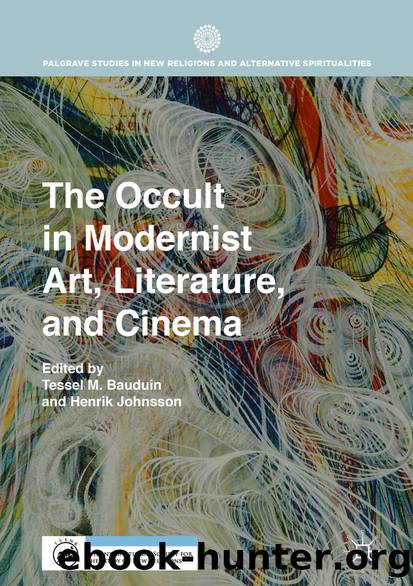The Occult in Modernist Art, Literature, and Cinema by Tessel M. Bauduin & Henrik Johnsson

Author:Tessel M. Bauduin & Henrik Johnsson
Language: eng
Format: epub
Publisher: Springer International Publishing, Cham
The Legendarium
Guided by the morphology of Péladan’s work, I observed and recorded the patterns emerging from the array of genres he used: firstly, his mythopoeia and metaphysical exegesis expressed through fiction, dialogue, and commentary; secondly, his aesthetic philosophy expressed through aphorisms; and finally, what might be termed esoteric psychology and social commentary expressed through fiction and didactic annotations.
To achieve this, I applied a simple taxonomy and cross-referenced the main motifs and internal referential framework. I then researched the intellectual history of the most significant ones, documenting Péladan’s reception and commentary on them. This made it possible to identify his ‘legendarium’, a term justified by the coherence, consistency, and continuity running through all of his works. In mapping his cosmogony, I discovered where the guides for self-initiation and the literature fitted in his schema, guided by his tables of concordances, his pre-announcements of publications, and his habit of cross-referencing himself in both his theoretical and his fictional work.19
The final piece of the puzzle was the substantiation of the extent of the Platonic influence on Péladan, which resolved the provocative question of why Péladan had dismissed the more ‘traditional’ and hierarchical esoteric approaches favoured by his contemporaries and had instead attempted to create his own system. His focus on Plato appears to have occurred for the same reason as his preoccupation with Assyrian deities; he had sought the oldest and clearest expression of art and philosophy that, in the context of his cosmology, most purely reflected the teachings of the first divine messengers—or daemons—to guide mankind. Péladan attempted to ‘prove’ Plato’s access to daemonic teachings by correlating the Symposium, Péladan’s revised version of Genesis, and 1 Enoch . Convinced that these sources corroborated each other, Péladan turned to Plato because he provided what the other sources did not: rational, intellectual philosophy presented through narrative, dialogue, and myth. It is hardly surprising, then, that Péladan sought to emulate a similar mixture of genres in his attempt to contextualize these teachings for his time. Instead of the Symposium, we have dialogues and mythical interludes in his 1888 novel Istar. Instead of the Socratic dialogues, we have Péladan’s colourful novels and didactic handbooks, and instead of Kallipolis, we have the Rose-Croix fraternity withdrawing into their enclave to preserve the remains of Western culture—both in his fiction and in real life.
This should suffice to demonstrate why it would not have been sufficient to only identify the Platonic influence in Péladan’s work, without exploring the use to which he put it. A primarily historiographical approach would have focused on Péladan’s reception of Platonic thought. A primarily literary approach would have entailed delving into Péladan’s literary expression of Platonic thought. Instead, I strove to discover how Platonic concepts functioned within Péladan’s work and how his affinity for Platonic thought shaped his oeuvre. This exploration was carefully contextualized to demonstrate the interplay between various cultural forces that partially explained Péladan’s synthesis of Platonic thought with other currents.
The same applies to Péladan’s Luciferianism. Through his retelling of the stories of
Download
This site does not store any files on its server. We only index and link to content provided by other sites. Please contact the content providers to delete copyright contents if any and email us, we'll remove relevant links or contents immediately.
The Secret History by Donna Tartt(18212)
Red Sparrow by Jason Matthews(5203)
Harry Potter 02 & The Chamber Of Secrets (Illustrated) by J.K. Rowling(3559)
In a Sunburned Country by Bill Bryson(3376)
Drawing Cutting Edge Anatomy by Christopher Hart(3298)
Figure Drawing for Artists by Steve Huston(3276)
Harry Potter and the Prisoner of Azkaban (Book 3) by J. K. Rowling(3119)
The Daily Stoic by Holiday Ryan & Hanselman Stephen(3113)
Japanese Design by Patricia J. Graham(3005)
The Roots of Romanticism (Second Edition) by Berlin Isaiah Hardy Henry Gray John(2823)
Make Comics Like the Pros by Greg Pak(2763)
Stacked Decks by The Rotenberg Collection(2696)
Harry Potter and the Deathly Hallows (7) by J.K. Rowling(2554)
Draw-A-Saurus by James Silvani(2512)
Tattoo Art by Doralba Picerno(2496)
On Photography by Susan Sontag(2493)
Foreign Devils on the Silk Road: The Search for the Lost Treasures of Central Asia by Peter Hopkirk(2389)
Churchill by Paul Johnson(2374)
The Daily Stoic by Ryan Holiday & Stephen Hanselman(2351)
